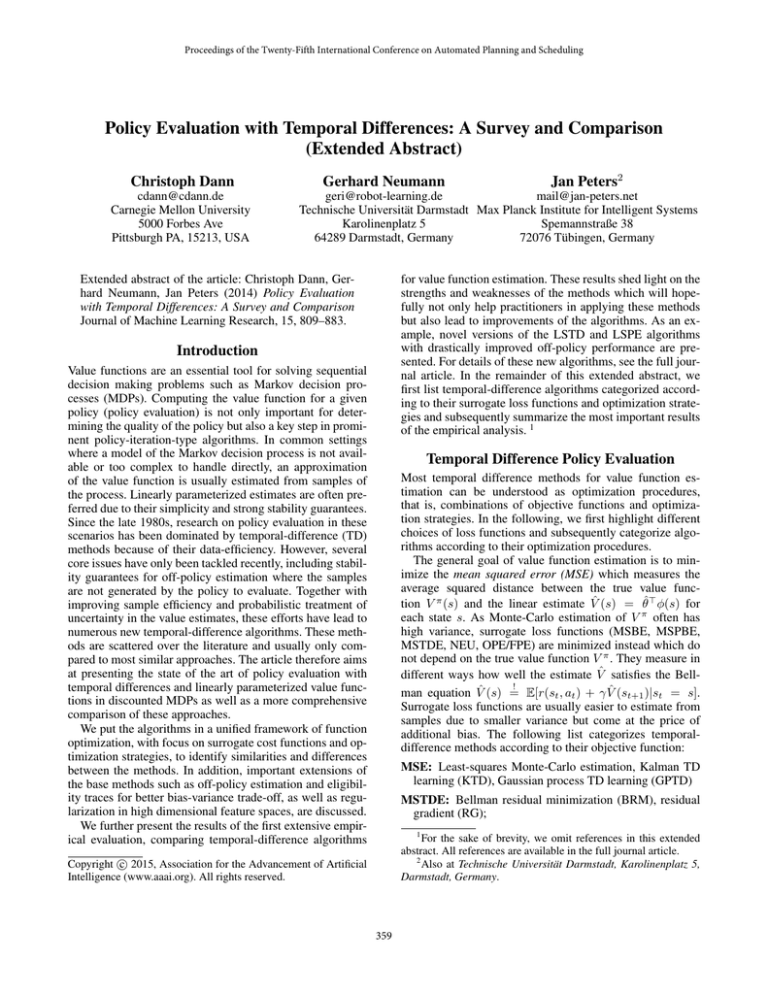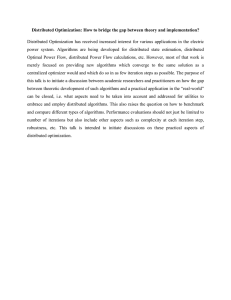
Proceedings of the Twenty-Fifth International Conference on Automated Planning and Scheduling
Policy Evaluation with Temporal Differences: A Survey and Comparison
(Extended Abstract)
Christoph Dann
cdann@cdann.de
Carnegie Mellon University
5000 Forbes Ave
Pittsburgh PA, 15213, USA
Gerhard Neumann
Jan Peters2
mail@jan-peters.net
geri@robot-learning.de
Technische Universität Darmstadt Max Planck Institute for Intelligent Systems
Spemannstraße 38
Karolinenplatz 5
64289 Darmstadt, Germany
72076 Tübingen, Germany
Extended abstract of the article: Christoph Dann, Gerhard Neumann, Jan Peters (2014) Policy Evaluation
with Temporal Differences: A Survey and Comparison
Journal of Machine Learning Research, 15, 809–883.
for value function estimation. These results shed light on the
strengths and weaknesses of the methods which will hopefully not only help practitioners in applying these methods
but also lead to improvements of the algorithms. As an example, novel versions of the LSTD and LSPE algorithms
with drastically improved off-policy performance are presented. For details of these new algorithms, see the full journal article. In the remainder of this extended abstract, we
first list temporal-difference algorithms categorized according to their surrogate loss functions and optimization strategies and subsequently summarize the most important results
of the empirical analysis. 1
Introduction
Value functions are an essential tool for solving sequential
decision making problems such as Markov decision processes (MDPs). Computing the value function for a given
policy (policy evaluation) is not only important for determining the quality of the policy but also a key step in prominent policy-iteration-type algorithms. In common settings
where a model of the Markov decision process is not available or too complex to handle directly, an approximation
of the value function is usually estimated from samples of
the process. Linearly parameterized estimates are often preferred due to their simplicity and strong stability guarantees.
Since the late 1980s, research on policy evaluation in these
scenarios has been dominated by temporal-difference (TD)
methods because of their data-efficiency. However, several
core issues have only been tackled recently, including stability guarantees for off-policy estimation where the samples
are not generated by the policy to evaluate. Together with
improving sample efficiency and probabilistic treatment of
uncertainty in the value estimates, these efforts have lead to
numerous new temporal-difference algorithms. These methods are scattered over the literature and usually only compared to most similar approaches. The article therefore aims
at presenting the state of the art of policy evaluation with
temporal differences and linearly parameterized value functions in discounted MDPs as well as a more comprehensive
comparison of these approaches.
We put the algorithms in a unified framework of function
optimization, with focus on surrogate cost functions and optimization strategies, to identify similarities and differences
between the methods. In addition, important extensions of
the base methods such as off-policy estimation and eligibility traces for better bias-variance trade-off, as well as regularization in high dimensional feature spaces, are discussed.
We further present the results of the first extensive empirical evaluation, comparing temporal-difference algorithms
Temporal Difference Policy Evaluation
Most temporal difference methods for value function estimation can be understood as optimization procedures,
that is, combinations of objective functions and optimization strategies. In the following, we first highlight different
choices of loss functions and subsequently categorize algorithms according to their optimization procedures.
The general goal of value function estimation is to minimize the mean squared error (MSE) which measures the
average squared distance between the true value function V π (s) and the linear estimate V̂ (s) = θ̂> φ(s) for
each state s. As Monte-Carlo estimation of V π often has
high variance, surrogate loss functions (MSBE, MSPBE,
MSTDE, NEU, OPE/FPE) are minimized instead which do
not depend on the true value function V π . They measure in
different ways how well the estimate V̂ satisfies the Bell!
man equation V̂ (s) = E[r(st , at ) + γ V̂ (st+1 )|st = s].
Surrogate loss functions are usually easier to estimate from
samples due to smaller variance but come at the price of
additional bias. The following list categorizes temporaldifference methods according to their objective function:
MSE: Least-squares Monte-Carlo estimation, Kalman TD
learning (KTD), Gaussian process TD learning (GPTD)
MSTDE: Bellman residual minimization (BRM), residual
gradient (RG);
1
For the sake of brevity, we omit references in this extended
abstract. All references are available in the full journal article.
2
Also at Technische Universität Darmstadt, Karolinenplatz 5,
Darmstadt, Germany.
c 2015, Association for the Advancement of Artificial
Copyright Intelligence (www.aaai.org). All rights reserved.
359
MSBE: BRM with double sampling (BRM DS), residual
gradient with double sampling (RG DS);
MSPBE: GTD2, TDC, Least-squares TD-learning
(LSTD);
OPE/FPE: Least-squared policy evaluation (LSPE), fixedpoint Kalman filtering (FPKF), TD learning;
NEU: GTD.
While the loss function mostly determines the quality of the
value function after convergence, the optimization strategy
defines the convergence speed and the computational costs
of an algorithm. There are roughly three classes of strategies.
Gradient-based methods: (TD learning, GTD, GTD2,
TDC, residual gradient) Steps along the stochastic gradient are taken. Algorithms can be employed online and
have per-step-runtime linear in the number of features but
heavily depend on good choices of step lengths.
Least-squares methods: (LSTD, LSPE, FPKF, BRM)
These methods compute the minimum of their quadratic
and convex loss function directly and converge much
faster than gradient-based methods. However, they have
quadratic runtime complexity.
Bayesian approaches: (KTD, GPTD) Bayesian approaches minimize the MSE but mitigate the issue
of high variance by incorporating prior beliefs which
introduce a bias. Their optimization strategy directly
originates from belief updates and usually has quadratic
runtime complexity.
•
•
•
•
•
•
Empirical Comparison
•
While there have been several impressive theoretical analyses of temporal-difference methods, which lead to guarantees and better understanding of them, many question
remained open. For example, it has been shown that the
MSPBE minimum can be arbitrarily far away from the desired MSE minimum, while the distance between MSBE and
MSE minimum (its bias) can be bounded. However, how relevant is this bound in practice? Which surrogate objective
has usually lower bias? The article therefore presents a systematic experimental study that aims at empirically answering these questions.
To this end, twelve benchmark problems have been selected, including classic benchmarks, tasks with continuous
and discrete state spaces, on- and off-policy scenarios, as
well as problems of different size. The performance of all algorithms (including eligibility traces, if available) has been
evaluated on these benchmarks in terms of the different objective functions. In addition, the effect of algorithm parameters across all benchmarks has been investigated in extensive parameter studies. The following list summarizes the
main results:
• Empirically, the magnitudes of objective biases, that
is, the distance of surrogate objective minima to the
MSE optimum, are: bias(MSTDE) ≥ bias(MSBE) ≥
bias(MSPBE) = bias(NEU) = bias(OPE/FPE).
• Optimizing for the MSBE objective instead of the
MSTDE objective by using double samples introduces
high variance in the estimate. Particularly, Bellman residual minimization requires stronger regularization which
results in slower convergence than relying on one sample
per transition.
Interpolating between the MSPBE/MSTDE surrogate objectives and the MSE cost function with eligibility traces
can improve the performance of policy evaluation.
Normalization of features for the linear parameterization
of the value-function estimate is crucial for the prediction
quality of gradient-based temporal-difference methods.
The GTD algorithm consistently performs worse than
its successors GTD2 and TDC. The TDC method finds
the surrogate objective minimum faster than the other
gradient-based algorithms GTD, GTD2 and TD learning.
By optimizing algorithm parameters, the TDC algorithm
performs always at least as good as TD-learning, but
comes at the price of optimizing an additional hyperparameter. Often, hyper-parameter optimization yields
very small values for the second learning rate, in which
case TDC reduces to TD-learning.
In general, the LSTD and LSPE algorithms produce the
predictions with lowest errors for sufficiently many observations.
In practice, LSTD and LSPE algorithms perform well
with off-policy samples only if transition reweighting
(proposed in the journal article) is used. The variance of
LSTD with standard reweighting makes the algorithm unusable in practice.
For a modest number of features, least-squares methods
are superior to gradient-based approaches both in terms
of data-efficiency and even CPU-time to reach the same
error level. For a very large number of features (e.g.,
≥ 20,000), gradient-based methods should be preferred as
least-squares approaches become prohibitively time- and
memory-consuming.
Conclusion
The article presents a concise survey of temporal difference
methods for linear value function estimation including recent trends such as regularization and feature generation to
deal with high-dimensional feature spaces. It also presents
the results of the first comprehensive empirical comparison
that provides evidence for several important questions regarding algorithm stability, parameter choices and surrogate
loss functions. The article could therefore be a helpful guide
for practitioners to choose the most suitable algorithm for
the problem at hand. It further aids researchers to identify
possible opportunities for improvements, as shown by the
new sample reweighting strategy for LSTD and LSPE proposed and empirically validated in the journal article.
360






